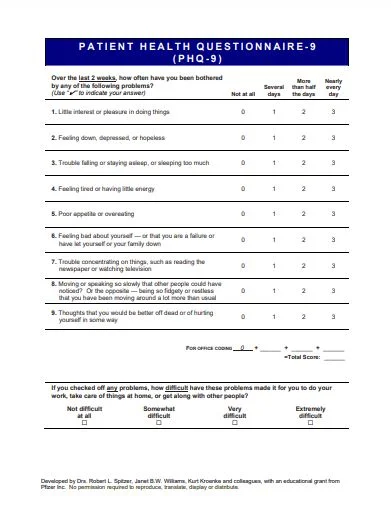‘Patient Health Questionnaire 9’ PDF Quick download link is given at the bottom of this article. You can see the PDF demo, size of the PDF, page numbers, and direct download Free PDF of ‘Patient Health Questionnaire 9’ using the download button.
Patient Health Questionnaire (PHQ-9) PDF Free Download

The Patient Health Questionnaire (PHQ-9) – Overview
The PHQ-9 is a multipurpose instrument for screening, diagnosing, monitoring, and measuring the severity of depression:
The PHQ-9 incorporates DSM-IV depression diagnostic criteria with other leading major depressive symptoms into a brief self-report tool.
The tool rates the frequency of the symptoms which factors into the scoring severity index.
Question 9 on the PHQ-9 screens for the presence and duration of suicide ideation. A follow-up, non-scored question on the PHQ-9 screens and assigns weight to the degree to which depressive problems have affected the patient’s level of function.
Clinical Utility
The PHQ-9 is brief and useful in clinical practice. The PHQ-9 is completed by the patient in minutes and is rapidly scored by the clinician. The PHQ-9 can also be administered repeatedly, which can reflect improvement or worsening of depression in response to treatment.
Scoring
See PHQ-9 Scoring on the next page.
Psychometric Properties
The diagnostic validity of the PHQ-9 was established in studies involving 8 primary care and obstetrical clinics.
PHQ scores > 10 had a sensitivity of 88% and a specificity of 88% for major depression.
PHQ-9 scores of 5, 10, 15, and 20 represent mild, moderate, moderately severe, and severe depression.
The Patient Health Questionnaire (PHQ-9) Scoring
Use of the PHQ-9 to Make a Tentative Depression Diagnosis:
The clinician should rule out physical causes of depression, normal bereavement and a history of a manic/hypomanic episode
Step 1: Questions 1 and 2
Need one or both of the first two questions endorsed as a “2” or a “3”
(2=”More than half the days” or 3= “Nearly every day”)
Step 2: Questions 1 through 9
Need a total of five or more boxes endorsed within the shaded area of the form to arrive at the total symptom count. (Questions 1-8 must be endorsed as a “2” or a “3”; Question 9 must be endorsed as “1” a “2” or a “3”)
Step 3: Question 10
This question must be endorsed as “Somewhat difficult” or “Very difficult” or “Extremely difficult”
Use of the PHQ-9 for Treatment Selection and Monitoring
Step 1
A depression diagnosis that warrants treatment or a treatment change, needs at least one of the first two questions endorsed as positive (“more than half the days” or “nearly every day”) in the past two weeks. In addition, the tenth question, about difficulty at work or home or getting along with others should be answered at least “somewhat difficult”
Step 2
Add the total points for each of the columns 2-4 separately
(Column 1 = Several days; Column 2 = More than half the days; Column 3 = Nearly every day. Add the totals for each of the three columns together. This is the Total Score
The Total Score = the Severity Score
The Patient Health Questionnaire 9 (PHQ-9) is a widely used screening tool used to assess and monitor the severity of depression. It consists of nine questions that help healthcare professionals evaluate a person’s mental health and determine the presence and severity of depressive symptoms. The PHQ-9 is often utilized in primary care settings and mental health assessments.
Each question in the PHQ-9 focuses on one of the nine criteria for major depressive disorder as outlined in the Diagnostic and Statistical Manual of Mental Disorders (DSM-5).
The questions inquire about various symptoms, such as mood, energy levels, sleep patterns, appetite, and concentration. Individuals are asked to rate the frequency of these symptoms over the past two weeks using a scale that typically ranges from “Not at all” to “Nearly every day.”
The total score on the PHQ-9 ranges from 0 to 27, with higher scores indicating more severe depressive symptoms. The scores are often categorized as follows:
- 0-4: Minimal or no depression
- 5-9: Mild depression
- 10-14: Moderate depression
- 15-19: Moderately severe depression
- 20-27: Severe depression
Healthcare professionals use the PHQ-9 results to guide treatment decisions, monitor progress, and determine the need for further evaluation or intervention. It’s important to note that while the PHQ-9 is a valuable tool, it is not a formal diagnostic tool; a clinical assessment by a qualified healthcare provider is necessary for a definitive diagnosis.
| Language | English |
| No. of Pages | 1 |
| PDF Size | 0.1 MB |
| Category | Health |
| Source/Credits | apa.org |
Related PDFs
BD Chaurasia General Anatomy PDF
Patient Health Questionnaire (PHQ-9) PDF Free Download
